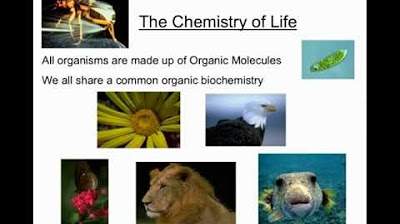What Is Organic Chemistry?: Crash Course Organic Chemistry #1
Summary
TLDRCrash Course Organic Chemistry introduces the study of carbon-based molecules, which are ubiquitous in nature and essential to modern life. The course delves into organic chemistry's history, starting from ancient medicinal plant uses to the modern synthesis of compounds like urea. It covers various ways to represent molecules, including Lewis structures, condensed formulas, and skeletal formulas. The video also highlights the importance of functional groups and heteroatoms in organic compounds, emphasizing their role in daily life from fabric dyes to caffeine in coffee.
Takeaways
- 🌟 Chemistry is the science of everything, with all matter composed of atoms that interact in various ways.
- 🔍 Organic chemistry specifically focuses on molecules containing carbon atoms, which can form diverse and complex structures.
- 📚 The term 'organic chemistry' was coined by Jöns Jacob Berzelius and initially referred to compounds derived from living organisms.
- 🌿 Ancient civilizations used organic compounds, such as those found in plants, for medicinal purposes and dyeing fabrics.
- 💧 Urea, a compound found in urine, was historically used as a dye mordant to enhance and preserve fabric colors.
- 🚀 Friedrich Wöhler's synthesis of urea from an inorganic compound in 1828 marked the beginning of the modern organic chemical industry.
- 📝 Lewis structures are used to represent the bonding and electron pairs in organic molecules, providing a detailed view of their composition.
- 📐 Condensed structural formulas and skeletal formulas offer simplified ways to depict organic molecules, focusing on key structural elements.
- 🌈 Heteroatoms, or atoms other than carbon and hydrogen, play a significant role in organic compounds, often determining their reactivity and function.
- 🌐 Organic compounds are ubiquitous in modern life, from the caffeine in our coffee to the polymers in our electronic devices.
Q & A
What is the focus of the Crash Course Organic Chemistry?
-The focus of the Crash Course Organic Chemistry is on the study of molecules that have carbon atoms, which often bond to themselves to form various compounds.
Why is carbon significant in organic chemistry?
-Carbon is significant in organic chemistry because it has four valence electrons, allowing it to form four bonds, which leads to the creation of diverse and complex organic compounds.
What was the historical belief about the origin of organic compounds?
-Historically, it was believed that organic compounds could only be harvested from living things and not synthesized artificially.
Who is credited with the discovery that organic matter could be synthesized from inorganic compounds?
-German chemist Friedrich Wöhler is credited with the discovery that an inorganic salt, ammonium cyanate, could be used to make urea without a living organism.
What is the role of urea in fabric dyeing?
-Urea acts as a fabric dye mordant, enhancing the color and longevity of the dye by forming a chemical bridge between the dye molecule and the fabric.
What is the significance of Wöhler's discovery in 1828 in the context of organic chemistry?
-Wöhler's discovery in 1828 marked the starting point of the modern organic chemical industry, demonstrating that organic compounds could be synthesized from inorganic materials.
What are the different ways to represent organic molecules?
-Organic molecules can be represented through Lewis structures, condensed structural formulas, and skeletal formulas or line-angle formulas.
Why are skeletal formulas useful in organic chemistry?
-Skeletal formulas are useful because they simplify the representation of organic molecules by removing explicit hydrogen atoms and carbon atoms, focusing instead on the bonds and functional groups.
What are heteroatoms in organic compounds?
-Heteroatoms are atoms in organic molecules other than carbon and hydrogen, such as nitrogen, oxygen, sulfur, and halogens.
What is the importance of functional groups in organic chemistry?
-Functional groups are parts of organic structures that include non-carbon atoms or have double and triple bonds, and they are where most of the interesting chemistry occurs.
How did the ancient Romans utilize urea?
-The ancient Romans used urea, a component of urine, as a dye additive, particularly for indigo dye, to enhance the color and make the dye last longer.
Outlines

This section is available to paid users only. Please upgrade to access this part.
Upgrade NowMindmap

This section is available to paid users only. Please upgrade to access this part.
Upgrade NowKeywords

This section is available to paid users only. Please upgrade to access this part.
Upgrade NowHighlights

This section is available to paid users only. Please upgrade to access this part.
Upgrade NowTranscripts

This section is available to paid users only. Please upgrade to access this part.
Upgrade NowBrowse More Related Video

Clase U12-Fundamentos de Química Orgánica-1° Parte-Alcanos

The Functional Group Concept Explained | Organic Chemistry | FuseSchool

Polarity, Resonance, and Electron Pushing: Crash Course Organic Chemistry #10

QUÍMICA ORGÂNICA | Comece aqui

Organic Biochemistry Screencast Session 1.mp4

The Basics of Organic Nomenclature: Crash Course Organic Chemistry #2
5.0 / 5 (0 votes)